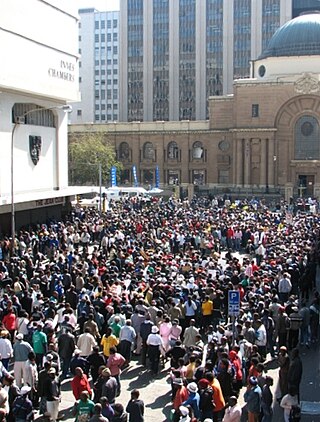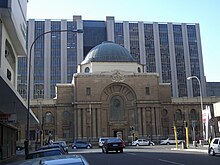
South Africa is divided into nine provinces. On the eve of the 1994 general election, South Africa's former homelands, also known as Bantustans, were reintegrated, and the four existing provinces were divided into nine. The twelfth, thirteenth and sixteenth amendments to the Constitution of South Africa changed the borders of seven of the provinces.

The Province of the Transvaal, commonly referred to as the Transvaal, was a province of South Africa from 1910 until 1994, when a new constitution subdivided it following the end of apartheid. The name "Transvaal" refers to the province's geographical location to the north of the Vaal River. Its capital was Pretoria, which was also the country's executive capital.

Gauteng is one of the nine provinces of South Africa. The name in Sotho-Tswana languages means 'place of gold'.

The High Court of South Africa is a superior court of law in South Africa. It is divided into nine provincial divisions, some of which sit in more than one location. Each High Court division has general jurisdiction over a defined geographical area in which it is situated. The decisions of a division are binding on magistrates' courts within its area of jurisdiction. The High Court has jurisdiction over all matters, but it usually only hears civil matters involving more than 400,000 rand, and serious criminal cases. It also hears any appeals or reviews from magistrates' courts and other lower courts.

South Africa has a 'hybrid' or 'mixed' legal system, formed by the interweaving of a number of distinct legal traditions: a civil law system inherited from the Dutch, a common law system inherited from the British, and a customary law system inherited from indigenous Africans. These traditions have had a complex interrelationship, with the English influence most apparent in procedural aspects of the legal system and methods of adjudication, and the Roman-Dutch influence most visible in its substantive private law. As a general rule, South Africa follows English law in both criminal and civil procedure, company law, constitutional law and the law of evidence; while Roman-Dutch common law is followed in the South African contract law, law of delict (tort), law of persons, law of things, family law, etc. With the commencement in 1994 of the interim Constitution, and in 1997 its replacement, the final Constitution, another strand has been added to this weave.
Quartus de Wet was a South African judge who served as Judge President of the Transvaal Provincial Division of the Supreme Court of South Africa.
The Supreme Court of South Africa was a superior court of law in South Africa from 1910 to 1997. It was made up of various provincial and local divisions with jurisdiction over specific geographical areas, and an Appellate Division which was the highest appellate court in the country.

The courts of South Africa are the civil and criminal courts responsible for the administration of justice in South Africa. They apply the law of South Africa and are established under the Constitution of South Africa or under Acts of the Parliament of South Africa.
The Eastern Cape Division of the High Court of South Africa is a superior court of law with general jurisdiction over the Eastern Cape province of South Africa. The main seat of the division is at Makhanda, with subordinate local seats at Port Elizabeth, East London, Bhisho and Mthatha. As of November 2017 the Judge President of the division is Selby Mbenenge.

The KwaZulu-Natal Division of the High Court of South Africa is a superior court of law with general jurisdiction over the KwaZulu-Natal province of South Africa. The main seat of the division is at Pietermaritzburg, while a subordinate local seat at Durban has concurrent jurisdiction over the coastal region of the province. As of August 2013 the Judge President of the division is Chiman Patel.
The North West Division of the High Court of South Africa is a superior court of law with general jurisdiction over the western part of North West province of South Africa. The division sits at Mahikeng.
The Limpopo Division of the High Court of South Africa is a superior court of law with general jurisdiction over the Limpopo province of South Africa. The main seat of the court in Polokwane opened on 25 January 2016. The court also has local seats at Thohoyandou and Lephalale. Before the opening of the division, the Gauteng Division at Pretoria had jurisdiction over Limpopo and circuit courts sat at Polokwane.

The government of Gauteng province in South Africa consists of a unicameral legislature elected by proportional representation, and an executive branch headed by a Premier who is elected by the legislature.
Sir Johannes (John) Wilhelmus Wessels (1862–1936) was an Afrikaner judge of the Appellate Division from 1923 to 1936 and Chief Justice of South Africa from 1932 to 1936.
Frans Lourens Herman Rumpff, was the Chief Justice of South Africa from 1974 to 1982.
Benjamin Arthur Tindall KC was a South African judge who served as Judge President of the Transvaal Provincial Division of the Supreme Court of South Africa and Judge op Appeal.
Leopold Greenberg KC was a South African judge who served as Judge President of the Transvaal Provincial Division of the Supreme Court of South Africa and Judge of Appeal.
Wessel Groenewald Boshoff QC was a South African judge, Judge President of the Transvaal Provincial Division of the Supreme Court of South Africa and Judge of Appeal.
Petrus Malan Cillié QC was a South African jurist, Judge President of the Transvaal Provincial Division of the Supreme Court of South Africa and Judge op Appeal.










